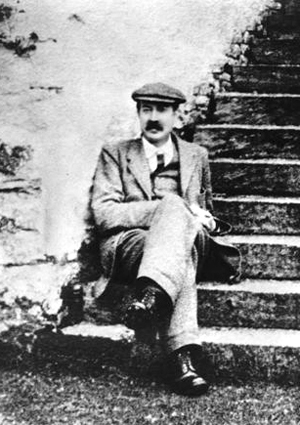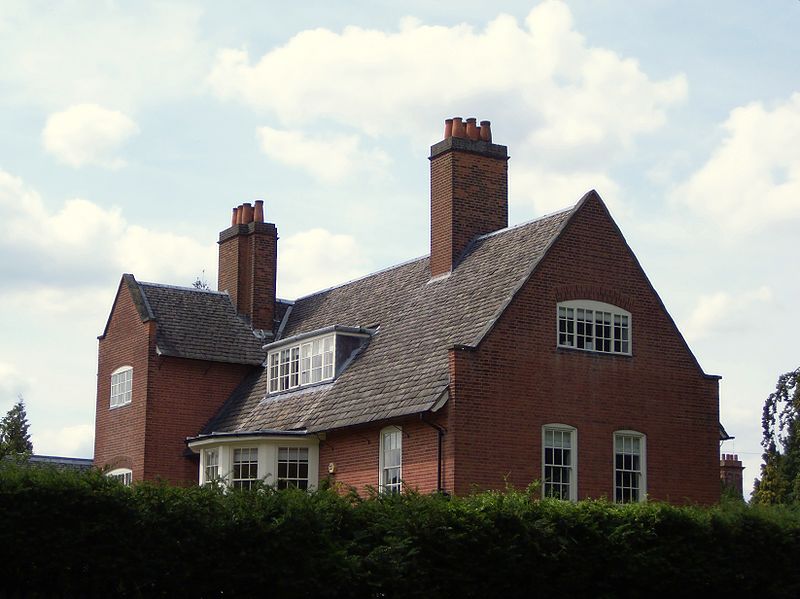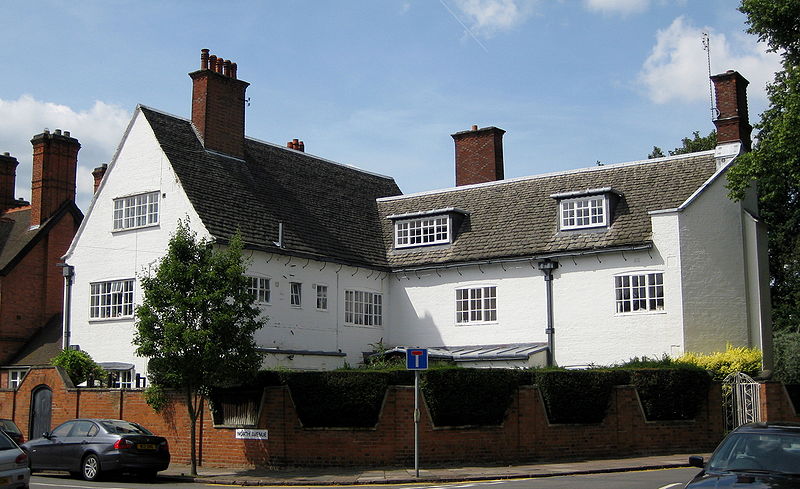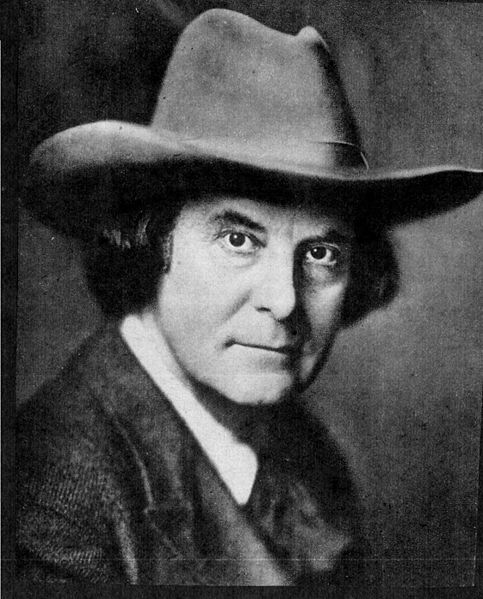<Back to Index>
- Metalsmith Dirk Koperlager van Erp, 1860
- Furniture Designer and Architect Ernest William Gimson, 1864
- Writer, Artist and Philosopher Elbert Green Hubbard, 1856
PAGE SPONSOR
Dirk Koperlager van Erp (1860 - 1933) was a Dutch American artisan, coppersmith and metalsmith, best known for lamps made of copper with mica shades, and also for copper vases, bowls and candlesticks. He was a prominent participant in the Arts and Crafts Movement, and was active in Oakland and San Francisco, California.
Dirk van Erp was born January 1, 1860, in Leeuwarden, the Netherlands. His father and other family members were coppersmiths. He immigrated to the United States in 1886, and came to San Francisco in 1890, where he went to work for Union Iron Works. In 1892, he married Mary Richardson Marino and their first child, a daughter named Agatha, was born in 1894. In 1898, he traveled to the Yukon during the Klondike Gold Rush, but failed to find his fortune. He returned to work at the Union Iron Works later that same year.
In 1900, he moved to Vallejo, California, and got a job as a coppersmith at the Mare Island Naval Shipyard. He began making lamps from brass shell casings as gifts to friends. He began consigning metal art works to local shops. His son, William Henry van Erp, was born in April 1901.
In 1908, he opened the Art Copper Shop in Oakland, and began exhibiting his work at local Arts and Crafts exhibitions. In 1909, he exhibited more than two dozen pieces at the Alaska - Yukon - Pacific Exposition, a World's Fair held in Seattle, Washington. His shop won a gold medal.
In 1910, he moved his shop to San Francisco, and entered into a partnership with Elizabeth Eleanor D'Arcy Gaw, (1860 - 1933) who had attended the Art Institute of Chicago. She had also studied English Arts and Crafts in London at the Guild and School of Handicraft, founded by Charles Robert Ashbee. Although their partnership lasted less than a year, she exerted a strong and lasting influence on van Erp's design sensibility. In 1915, van Erp exhibited at the Panama - Pacific International Exposition, a World's Fair held in San Francisco. During World War I, van Erp significantly reduced his artisan production, and returned to employment at Union Iron Works to contribute to the war effort. He resumed his prolific artisan production after the war ended in 1918.
His career continued until his retirement in 1929. He died in Fairfax, California, on July 18, 1933. His wife, Mary van Erp, died four hours later. His son, William van Erp, continued to operate the shop until 1977, when he died.
Kenneth Trapp, curator for decorative arts at the Oakland Museum of California summarized van Erp's legacy as follows: "Although most famous for his lamps, many of which are commanding in size and stunning in design, van Erp produced other pieces of such exceptional beauty and strength as to stand unrivaled in American metalwork." Trapp concluded, "Dirk van Erp is widely considered the most important metalsmith of the Arts and Crafts movement"
A copper and mica lamp ca. 1912 - 1915, designed by D'Arcy Gaw and Dirk van Erp, is in the collection of the Metropolitan Museum of Art in New York City. It was donated in 1989 by Charles and Jane Kaufman.
In June, 2002, a copper and mica lamp designed by D'Arcy Gaw and made by Dirk van Erp was sold for US$ 180,000 at an auction conducted by The Craftsman and David Rago in Lambertville, New Jersey. A van Erp copper vase sold for US$ 36,000 at the same auction.
On July 28, 2007, appraiser David Rago discussed a Dirk van Erp lamp on a segment of the Public Broadcasting Service series Antiques Roadshow (American version) filmed that day in Louisville, Kentucky. The value of the copper and mica lamp made around 1912 was estimated at US$ 40,000 to $50,000.
Mass produced copies of van Erp's designs are widely reproduced today, but tend to be of lower quality. Modern artisans continue to produce higher quality copper works inspired by van Erp and other classical Arts and Crafts coppermiths. Among them are the artisans of Michoacán, Mexico, whose works are sold under the Cobre brand name.

Ernest William Gimson (Leicester, 21 December 1864 - Sapperton, 12 August 1919) was an English furniture designer and architect. Gimson was described by the art critic Nikolaus Pevsner as "the greatest of the English architect - designers". Today his reputation is securely established as one of the most influential designers of the English Arts and Crafts movement in the late nineteenth and early twentieth centuries.
Ernest Gimson was born in Leicester, in the East Midlands of England, in 1864, the son of Josiah Gimson, engineer and iron founder, owner of the Vulcan Works. Ernest was articled to the Leicester architect, Isaac Barradale. Aged 20, he attended a lecture on 'Art and Socialism' at the Leicester Secular Society given by the leader of the Arts and Crafts revival in Victorian England, William Morris.
Morris recommended him to the architectural practice of John Dando Sedding in London. From Sedding, Gimson derived his interest in craft techniques, the stress on textures and surfaces, naturalistic detail of flowers, leaves and animals, always drawn from life, the close involvement of the architect in the simple processes of building and in the supervision of a team of craftsmen employed direct. He met Ernest Barnsley at Sedding’s studio, and soon learned the crafts of traditional chair making and plaster work.
In 1889 he joined Morris’s Society for the Protection of Ancient Buildings (SPAB). In 1890, he was a founder member of the short lived furniture company, Kenton and Co., with Sidney Barnsley, Alfred Hoare Powell, W.R. Lethaby, Mervyn Macartney, Col. Mallet and Reginald Blomfield. Here they acted as designers rather than craftsmen and explored inventive ways of articulating traditional crafts, "the common facts of traditional building", as Philip Webb, "their particular prophet", had taught.
Gimson and the Barnsley brothers moved to the rural region of the Cotswolds in Gloucestershire in 1893 "to live near to nature". They soon settled at Pinbury Park, near Sapperton, on the Cirencester estate, under the patronage of the Bathurst family. In 1900, he set up a small furniture workshop in Cirencester, moving to larger workshops at Daneway House, a small medieval manor house at Sapperton, where he stayed until his death in 1919. He strove to invigorate the village community and, encouraged by his success, planned to found a Utopian craft village. He concentrated on designing furniture, made by craftsmen, under his chief cabinet maker, Peter van der Waals, whom he engaged in 1901.
His architectural commissions include a number of early works such as Inglewood (1892) and The White House (1898) in the prosperous Leicester suburb of Stoneygate; Lea and Stoneywell Cottages (and others) near the Leicestershire village of Markfield (1897/8); his own cottage, The Leasowes, at Sapperton (1903, with a thatched roof, since burned); alterations to Pinbury Park (with plaster work) and Waterlane House (1908), both in Gloucestershire; cottages and the village hall (completed under Norman Jewson in 1933) at Kelmscott, Oxfordshire; Coxen, at Budleigh Salterton, Devon, constructed in cob (rammed earth); and the window for Whaplode Church, Lincolnshire. His competition 'Design for the Federal Capital of Australia' (1908) is an original project in town planning for the city which was to become Canberra. His last major project was the Memorial Library (1918 – 1919) built next to the 1911 Lupton Hall (also a Gimson design) at Bedales School, near Petersfield, Hampshire (built at his request by Geoffrey Lupton under Sidney Barnsley’s supervision and completed in 1921). In May, 2012 it was announced that the National Trust hoped to buy Stonywell and open it to the public.
The Sapperton workshop was closed after Gimson's death, but many of the craftsmen went with Peter van der Waals to his new premises in Chalford.
His architectural style is "solid and lasting as the pyramids… yet gracious and homelike" (H. Wilson, 1899). Lethaby described him as an idealist individualist: "Work not words, things not designs, life not rewards were his aims." Norman Jewson was his foremost student, who carried his design principles into the next generation and described his studio practices in his classic memoir By Chance I did Rove (1951).
Today his furniture and craft work is regarded as a supreme achievement of its period and is well represented in the principal collections of the decorative arts in Britain and the United States of America. Specialist collections of his work may be seen in England at the New Walk Museum, Leicester, and in Gloucestershire at the Cheltenham Art Gallery and Museum, Rodmarton Manor and Owlpen Manor.



Elbert Green Hubbard (June 19, 1856 – May 7, 1915) was an American writer, publisher, artist and philosopher. Raised in Hudson, Illinois, he met early success as a traveling salesman with the Larkin soap company. Today Hubbard is mostly known as the founder of the Roycroft artisan community in East Aurora, New York, an influential exponent of the Arts and Crafts Movement. Among his many publications were the nine volume work Little Journeys to the Homes of the Great and the short story A Message to Garcia. He and his second wife, Alice Moore Hubbard, died aboard the RMS Lusitania, which was sunk by a German submarine off the coast of Ireland on May 7, 1915.
Hubbard was born in Bloomington, Illinois, to Silas Hubbard and Juliana Frances Read on June 19, 1856. In the fall of 1855, his parents had relocated to Bloomington from Buffalo, New York, where his father had a medical practice. Finding it difficult to settle in Bloomington — mainly due to the presence of several already established doctors — Silas moved his family to Hudson, Illinois, the following year. Nicknamed "Bertie" by his family, Elbert had two older siblings: Charlie, who was largely bed ridden after a fall when he was young, and Hannah Frances, nicknamed "Frank" like her mother. Charlie died at the age of nine, when Elbert was three - and - a - half. Elbert also had three younger sisters who were named Mary, Anna Miranda, and Honor.
The Hubbard children attended the local public school, a small building with two rooms that overlooked the graveyard. Thirty years later, Elbert described his schooling days as "splendid" and "tinged with no trace of blue.... I had no ambitions then — I was sure that some day I could spell down the school, propound a problem in fractions that would puzzle the teacher, and play checkers in a way that would cause my name to be known throughout the entire township." Mary would remember her older brother's role as the school troublemaker, noting that he "annoyed his teachers... occasionally by roaring inappropriately when his too responsive sense of humor was tickled."
Elbert's first business venture was selling Larkin soap products, a career which eventually brought him to Buffalo, New York. His innovations for Larkin included premiums and "leave on trial".
Hubbard described himself as an anarchist and a socialist. He believed in social, economic, domestic, political, mental and spiritual freedom. In A Message to Garcia and Thirteen Other Things (1901), Hubbard explained his Credo by writing "I believe John Ruskin, William Morris, Henry Thoreau, Walt Whitman and Leo Tolstoy to be Prophets of God, and they should rank in mental reach and spiritual insight with Elijah, Hosea, Ezekiel and Isaiah."
Hubbard wrote a critique of war, law and government in the booklet Jesus Was An Anarchist (1910). Originally published as The Better Part in A Message to Garcia and Thirteen Other Things, Ernest Howard Crosby described Hubbard's essay as "The best thing Elbert ever wrote."
His best known work came after he founded Roycroft, an Arts and Crafts movement community in East Aurora, New York, in 1895. This grew from his private press which he had founded in collaboration with his first wife Bertha Crawford Hubbard, the Roycroft Press, inspired by William Morris's Kelmscott Press. (Although called the "Roycroft Press" by latter day collectors and print historians, the organization called itself "The Roycrofters" and "The Roycroft Shops".)
Hubbard edited and published two magazines, The Philistine and The Fra. The Philistine was bound in brown butcher paper and full of satire and whimsy. (Hubbard himself quipped that the cover was butcher paper because: "There is meat inside.") The Roycrofters produced handsome, if sometimes eccentric, books printed on handmade paper, and operated a fine bindery, a furniture shop, and shops producing modeled leather and hammered copper goods. They were a leading producer of Mission Style products.
Hubbard's second wife, Alice Moore Hubbard, was a graduate of the New Thought - oriented Emerson College of Oratory in Boston and a noted suffragist. The Roycroft Shops became a site for meetings and conventions of radicals, freethinkers, reformers, and suffragists. Hubbard became a popular lecturer, and his homespun philosophy evolved from a loose William Morris - inspired socialism to an ardent defense of free enterprise and American know - how. Hubbard was much mocked in the press for "selling out".
He received much criticism by saying, "Prison is a Socialist's Paradise, where equality prevails, everything is supplied and competition is eliminated."
In 1908, Hubbard was the keynote speaker at the annual meeting of The Society in Dedham for Apprehending Horse Thieves. In 1912, the famed passenger liner the Titanic was sunk after hitting an iceberg. Hubbard subsequently wrote of the disaster, singling out the story of Ida Straus, who as a woman was supposed to be placed on a lifeboat in precedence to the men, but she refused to board the boat: "Not I — I will not leave my husband. All these years we've traveled together, and shall we part now? No, our fate is one."
Hubbard then added his own stirring commentary:
"Mr. and Mrs. Straus, I envy you that legacy of love and loyalty left to your children and grandchildren. The calm courage that was yours all your long and useful career was your possession in death. You knew how to do three great things — you knew how to live, how to love and how to die. One thing is sure, there are just two respectable ways to die. One is of old age, and the other is by accident. All disease is indecent. Suicide is atrocious. But to pass out as did Mr. and Mrs. Isador Straus is glorious. Few have such a privilege. Happy lovers, both. In life they were never separated and in death they are not divided."
Elbert Hubbard married Bertha Crawford on June 30, 1881 in Bloomington, Illinois. Their marriage produced four children, Elbert Hubbard II, Sanford Hubbard, Ralph Hubbard and Catherine Hubbard, but ended in divorce after his notorious affair with a school-teacher in East Aurora Alice Morre, which produced a daughter Miriam Elberta Hubbard in 1894. Elbert and Alice married in 1904 and died together in the sinking of the Lusitania in 1915.
On May 1, 1915, little more than three years after the sinking of the Titanic, the Hubbards boarded the RMS Lusitania in New York City. On May 7, 1915, while at sea 11 miles (18 km) off the Old Head of Kinsale, Ireland, it was torpedoed and sunk by the German u-boat U-20.
In a letter to Elbert Hubbard II dated 12 March 1916, Ernest C. Cowper, a survivor of this event, wrote:
I can not say specifically where your father and Mrs. Hubbard were when the torpedoes hit, but I can tell you just what happened after that. They emerged from their room, which was on the port side of the vessel, and came on to the boat deck.Neither appeared perturbed in the least. Your father and Mrs. Hubbard linked arms — the fashion in which they always walked the deck — and stood apparently wondering what to do. I passed him with a baby which I was taking to a lifeboat when he said, 'Well, Jack, they have got us. They are a damn sight worse than I ever thought they were.'
They did not move very far away from where they originally stood. As I moved to the other side of the ship, in preparation for a jump when the right moment came, I called to him, 'What are you going to do?' and he just shook his head, while Mrs. Hubbard smiled and said, 'There does not seem to be anything to do.'
The expression seemed to produce action on the part of your father, for then he did one of the most dramatic things I ever saw done. He simply turned with Mrs. Hubbard and entered a room on the top deck, the door of which was open, and closed it behind him.
It was apparent that his idea was that they should die together, and not risk being parted on going into the water.
The Roycroft Shops, run by Hubbard's son, Elbert Hubbard II, operated until 1938.
Owing to his prolific publications, Hubbard was a renowned figure in his day. Contributors to a 360 page book published by Roycrofters and titled In Memoriam: Elbert and Alice Hubbard included such luminaries as meat packing magnate J. Ogden Armour, business theorist and Babson College founder Roger Babson, botanist and horticulturalist Luther Burbank, seed company founder W. Atlee Burpee, ketchup magnate Henry J. Heinz, National Park Service founder Franklin Knight Lane, success writer Orison Swett Marden, inventor of the modern comic strip Richard F. Outcault, poet James Whitcomb Riley, Nobel Peace Prize recipient Elihu Root, evangelist Billy Sunday, political leader Booker T. Washington, and poet Ella Wheeler Wilcox. Another book which was written by Mr. Hubbard is titled "Health and Wealth". It was published in 1908 and includes many short truisms that are in line with the Truth movement and Transcendentalists concerning using intelligence to rid one of fear and, thus, to bring the body back to health and happiness which leads to true wealth through service to others.
Today, remnants of Hubbard's contributions to the Arts & Crafts Movement still remain, and are embraced by the community of East Aurora, NY.